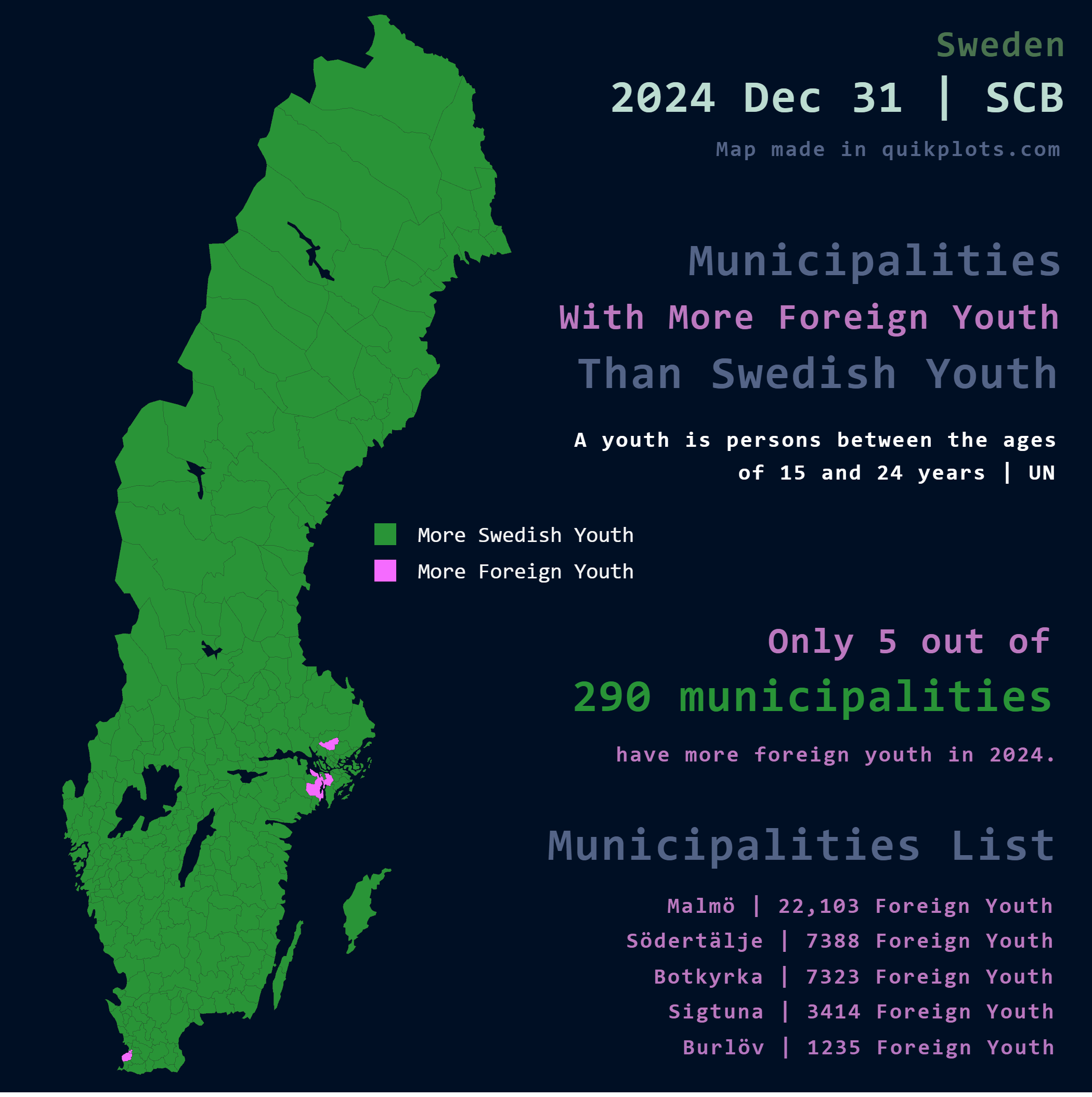Map of Foreign Youth Population in Sweden


David Chen
Data Visualization Specialist
David Chen is an expert in transforming complex geographic datasets into compelling visual narratives. He combines his background in computer science ...
Geographic Analysis
What This Map Shows
This map visualizes the distribution of foreign youth in Sweden, highlighting areas where individuals aged 15 to 25 with foreign backgrounds outnumber their Swedish counterparts. The data, sourced from Statistics Sweden (SCB), provides critical insights into the demographic shifts occurring across the country. As we delve deeper into this topic, it’s essential to understand the implications of these trends on Swedish society and culture.
Deep Dive into Youth Demographics in Sweden
Sweden has long been recognized for its strong commitment to inclusivity and diversity, attracting youth from various countries looking for better opportunities. The foreign youth demographic is defined as those who are either born outside Sweden or born in Sweden to foreign-born parents. In contrast, Swedish youth are those born to Swedish parents or born in Sweden to one Swedish parent and one foreign-born parent.
Interestingly, the Swedish youth population is facing significant competition from foreign youth in various urban areas, particularly in cities such as Stockholm, Gothenburg, and Malmö. According to the SCB data, certain neighborhoods are experiencing a remarkable transformation where foreign youth not only represent a significant portion of the population but, in some cases, exceed the number of Swedish youth.
The implications of this demographic shift are profound. For instance, urban areas with a higher concentration of foreign youth often showcase a vibrant mix of cultures, languages, and ideas. This diversity can lead to enhanced creativity and innovation, enriching the social fabric of communities. However, it can also pose challenges, such as the need for effective integration strategies and educational programs to support both foreign and native Swedish youth.
What's fascinating is that these shifts reflect broader global trends in migration and youth movements. Young people are often at the forefront of globalization, moving to urban centers in search of better education, employment opportunities, and lifestyle choices. The rise of tech hubs and creative industries in Swedish cities is also attracting a diverse pool of talent, resulting in a youth demographic that is increasingly multicultural.
Regional Analysis
When examining the map, it becomes evident that certain regions are more affected by the influx of foreign youth than others. For example, Stockholm stands out as a melting pot of cultures, with neighborhoods like Rinkeby and Tensta showing significant foreign youth populations. In these areas, the demographic makeup has shifted dramatically over the past two decades, transforming local schools and community centers into hubs of cultural exchange.
In contrast, rural areas of Sweden tend to have a more stable composition of Swedish youth. These regions often lack the same level of economic opportunity and may not attract as many foreign residents. However, smaller cities such as Uppsala and Örebro are also experiencing growth in the foreign youth population, albeit at a different pace than metropolitan areas. Here, educational institutions play a crucial role in attracting students from abroad, contributing to a more diverse youth landscape.
Interestingly, the map also highlights trends in regional economies. Areas with a high concentration of foreign youth often correlate with burgeoning tech and creative sectors, suggesting that diversity is a key driver of economic growth. Conversely, regions with slower growth may find their youth population stagnating, raising concerns about future workforce sustainability.
Significance and Impact
Understanding the dynamics of foreign youth in Sweden is essential for several reasons. Firstly, it allows policymakers and educators to adapt their strategies to ensure that all young people, regardless of background, have access to quality education and employment opportunities. As Sweden continues to embrace its multicultural identity, fostering inclusivity will be vital in promoting social cohesion and economic vitality.
Moreover, the trends observed in this map can serve as a case study for other nations grappling with similar demographic shifts. As globalization continues to shape our world, the movement of youth across borders will only intensify. Countries that successfully integrate diverse populations can benefit from increased creativity, innovation, and economic growth.
In conclusion, the map illustrating where foreign youth outnumber Swedish youth in Sweden is more than just a visualization; it’s a reflection of a changing society. As we look to the future, understanding these trends will be crucial in shaping a more inclusive and thriving Sweden, where all youth can contribute to and benefit from the rich tapestry of culture and opportunity.
Visualization Details
- Published
- October 8, 2025
- Views
- 6
Comments
Loading comments...